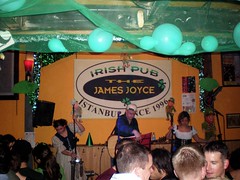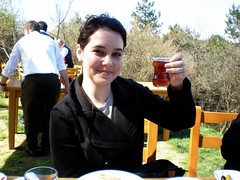This past weekend Erin and I went to Romania for a mini-break, about twenty years after my brother went there on a singing trip as a teenager back when Ceausescu was still in power. Even though we were only gone for three days, it felt more like a week and a half. We took the bus from Istanbul on Thursday at 3pm, arriving in Bucharest 12 hours later. We made our way to the train station and sat in the bar until 4:30am when McDonald's opened so we were able to have coffee and a snack. We hopped aboard the 6:30am train Friday morning from Bucharest to Brasov and spent the day sightseeing around Brasov: we took the cable car up Mt Tampa to the Brasov sign and hiked down, walked around the picturesque center, went to the historical museum, ate pizza loaded with pork products, and generally fit in as much as we could on two hours of sleep.
Saturday we woke up and had breakfast in the hostel with a group of Peace Corps volunteers over 50 who were just about to begin their service in Romania. Then we went to the station to take the bus to Bran to see Bran (Dracula's) Castle. We had fun in the souvenir market and while touring Bran Castle ran into some Americans who worked for NATO and were living in Izmir, Turkey (what are the odds of running into other Americans, also living in Turkey, in Romania?). They were very nice and were getting some sightseeing in before the NATO summit this coming week.
After heading back to Brasov we took the 4pm train to Sinaia where we tried to see as much as possible before sunset. We decided it would be easier to stay in Sinaia so we started to head up the mountain to a hotel recommended by Lonely Planet. We FINALLY made it, only to find the hotel closed but the restaurant open. While we ate we decided to try to make it to Bucharest that night. We went back down the mountain and tried to follow the Lonely Planet directions, but we ended up in a tiny town called Azuga feeling frustrated, so we went back to Sinaia only to find we had just missed the last train. We waited for awhile on the main road hoping we could hail a bus and after about fifteen minutes a young guy who spoke English offered to drive us. Once in Bucharest, he picked up his girlfriend and they drove us right to the hostel door which was incredibly nice of them, especially as by then it was about 1am.
Sunday morning we explored Bucharest. It was surprisingly empty (where were all the people?) and a little more...dilapidated than we were expecting. The buildings were grand and impressive, though the most impressive buildings were built by Ceausescu and have been left unfinished in the same state they were in twenty years ago when he was arrested and executed. We really wanted to take a tour of the Palace of Parliament, the largest administrative building in the world after the Pentagon, but sadly it was closed to the public due to the upcoming NATO summit. After being told it was closed, we went across the street and sat down to consult our map but a couple of seconds later we had three policemen around us (apparently we were loitering?) and the conversation went like this:
Post-communist policeman (PCP): What are you doing in Romania?
Us: We're tourists
PCP: Why are you at the Palace of Parliament?
Us: It's the top tourist attraction in Bucharest
PCP: Give me your passports
Erin: Seriously?!
PCP: (in Terminator voice) Seriously. (looked at our info pages, then handed them back)
me: Can you help us? We're looking for Filaret Station. Here's our map.
PCP: (looks at map) Go down that street. (points)
me: But that's the opposite direction of Filaret Station.
PCP: GO that way! (points down same street)
Us: But, uh, well, oh... oh, okay...
So we walked in the opposite direction we needed to go in just to humor the policemen. Eventually, we took a taxi to the station and I was able to have a conversation with the driver because Romanian sounds a lot like Italian, and with a romance language background I found it surprisingly accessible. We got the bus back to Istanbul, and made it home at 4am. A successful trip!




